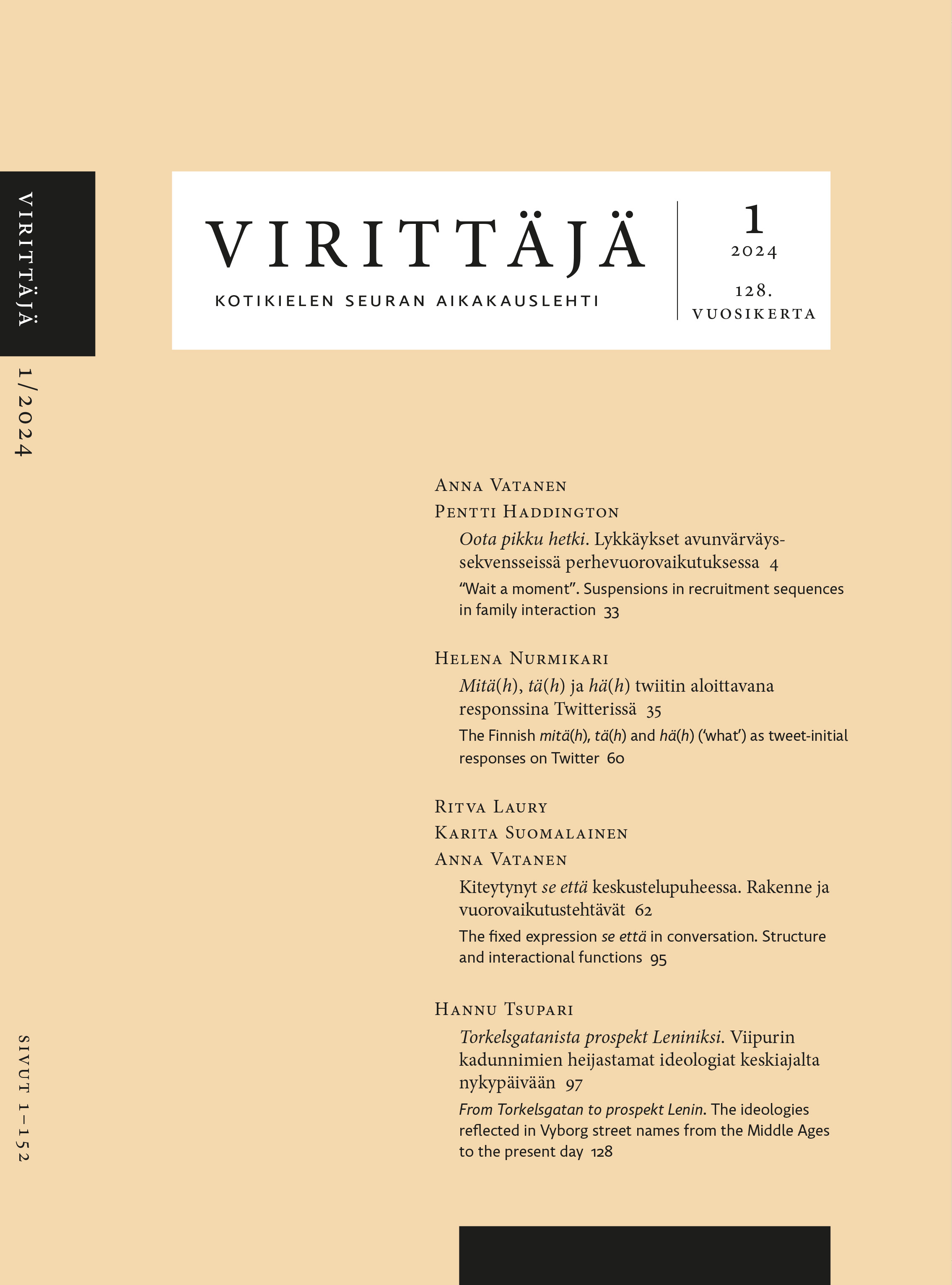Torkelsgatanista prospekt Leniniksi
Viipurin kadunnimien heijastamat ideologiat keskiajalta nykypäivään
Abstrakti
Artikkelissa selvitetään, millaisia jälkiä eri vallanpitäjät ovat jättäneet Viipurin keskustan kieli- ja nimimaisemaan kuuluviin kadunnimiin koko sen historian aikana. Valta on vaihtunut Viipurissa tiuhaan, mikä tekee tutkimuskohteesta mielenkiintoisen. Tutkimusaineistona ovat olleet Ruotsin kuningaskunnan, Venäjän keisarikunnan, Suomen suuriruhtinaskunnan, Suomen tasavallan, Neuvostoliiton ja Venäjän federaation aikaiset kuusi karttaa, joista kadunnimet on poimittu. Artikkelissa selvitetään kadunnimiä vertaamalla, millaisia Viipurin kadunnimet ovat olleet eri aikoina sekä miten eri vallanpitäjien ideologiat heijastuvat erityisesti muistonimiin.
Muistonimien analysoinnissa artikkelissa sovelletaan sekä kaupunkinimistön alkuperää selvittävää etymologista tutkimusta että erityisesti kriittisen onomastiikan piiriin kuuluvien kielimaisematutkimuksen ja kriittisen paikannimitutkimuksen menetelmiä. Artikkelissa pyritään nimenantajan nimeämismotiiveja tutkimalla selvittämään, miten muistonimet palvelevat vallankäyttöä ja piileviä valtarakenteita; lisäksi katujen nimien kautta voidaan päätellä, mikä versio historiasta näkyy kaupunkimaisemassa vallanpitäjien ideologispainotteisten valintojen tuloksena.
Artikkelissa ideologiset muistonimet jaetaan yhtäältä valtiolliseen tai poliittiseen valta-asemaan perustuviin henkilönnimiin ja toisaalta muihin ajalle tyypillistä poliittista symboliikkaa tai propagandaa heijastaviin ideologisiin nimiin. Tutkimus osoittaa, että valtiollis-poliittisiin henkilöihin viittaavia ideologisia muistonimiä on käytetty Viipurissa kaikkina ajanjaksoina. Tällaisten nimien osuus on ollut kasvava muihin muistonimiin verrattuna jo Suomen tasavallan aikana, mutta niiden ja erityisesti neuvostosymboliikkaa ja -propagandaa sisältävien muiden valtiollis-poliittiseen ideologiaan viittaavien nimien osuus on erityisen suuri Neuvostoliiton ja ehkä yllättäen myös Venäjän federaation aikoina. Kadunnimien painottuminen myös nyky-Viipurissa ideologisiin muistonimiin on havaittu myös muissa Venäjällä tehdyissä tutkimuksissa. Tässä tutkimuksessa esiteltyä muistonimien luokittelua voidaan soveltaa myös muihin suomalaisiin kaupunkeihin, kun halutaan selvittää kadunnimien heijastamia ideologioita.
From Torkelsgatan to Prospekt Lenin: The ideologies reflected in Vyborg street names from the Middle Ages to the present day
The article examines traces left by shifting political powers in the street names that have formed the linguistic and toponymical landscape of Vyborg city centre throughout its history. Power has changed hands many times in Vyborg, which makes the topic interesting and unique. The research material consists of six maps dating from the eras of the Kingdom of Sweden, the Russian Empire, the Grand Duchy of Finland, the Republic of Finland, the Soviet Union and the Russian Federation, and it is from these maps that the street names have been extracted. By comparing street names, the article examines which street names were used in Vyborg during the different eras and how these names reflect the ideologies of various rulers, particularly in commemorative names.
In the analysis of commemorative names, the article applies both etymological research that explains the origin of urban nomenclature and, in particular, the methods of linguistic landscape research and toponomastics in the field of critical onomastics. The aim of the present article is to investigate how commemorative names serve the exercise of power and hidden power structures, and which version of history is reflected in the urban landscape as a result of the ideological choices made by those in power.
Ideological commemorative names are divided into personal names based on state or political power on the one hand, and other ideological names that reflect political symbolism or propaganda typical of the era on the other. The study shows that ideological commemorative names referring to state political figures have been employed in Vyborg throughout all six eras. In comparison with other commemorative names, the proportion of such names was already increasing during the era of the Republic of Finland, but their proportion, and especially that of other names containing Soviet symbolism and propaganda and referring to state political ideology, is particularly high during the Soviet Union era and, perhaps surprisingly, also during the years of the Russian Federation. The predominance of ideological commemorative names – even in the street names of present-day Vyborg – has already been noted in other studies conducted in Russia. The classification of commemorative names presented in this article can also be applied to other Finnish cities to examine the ideologies reflected in the choice of street names.






